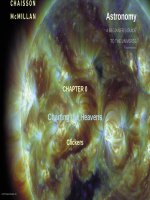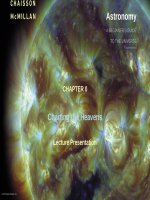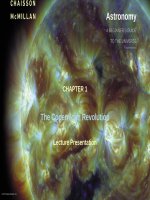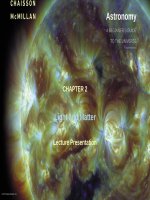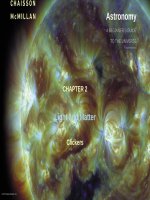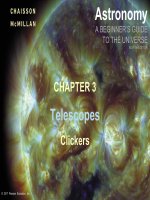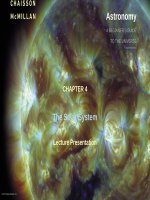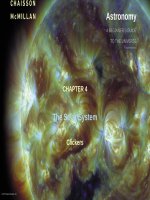Astronomy a beginners guide to the universe 8th CHaisson mcmillan chapter 01
Bạn đang xem bản rút gọn của tài liệu. Xem và tải ngay bản đầy đủ của tài liệu tại đây (2.26 MB, 22 trang )
Astronomy
A BEGINNER’S GUIDE
TO THE UNIVERSE
EIGHTH EDITION
CHAPTER 1
The Copernican Revolution
Lecture Presentation
© 2017 Pearson Education, Inc.
Chapter 1 The Copernican Revolution
© 2017 Pearson Education, Inc.
Units of Chapter 1
•
•
•
•
•
The Motions of the Planets
The Birth of Modern Astronomy
The Laws of Planetary Motion
Newton’s Laws
Summary of Chapter 1
© 2017 Pearson Education, Inc.
1.1 The Motions of the Planets
•
The Sun, Moon, and stars all have simple movements in the sky, consistent with an Earthcentered system.
•
Planets:
–
Move with respect to
fixed stars
–
–
–
–
Change in brightness
Change speed
Have retrograde motion
Are difficult to describe in
Earth-centered system
© 2017 Pearson Education, Inc.
1.1 The Motions of the Planets
•
A basic geocentric model, showing an epicycle (used to explain planetary motions)
© 2017 Pearson Education, Inc.
1.1 The Motions of the Planets
•
Lots of epicycles were needed to accurately track planetary motions, especially retrograde
motions. This is Ptolemy’s model.
© 2017 Pearson Education, Inc.
1.1 The Motions of the Planets
•
A heliocentric (Sun-centered) model of the solar system easily describes the observed
motions of the planets without excess complication.
© 2017 Pearson Education, Inc.
1.2 The Birth of Modern Astronomy
•
Observations of Galileo:
–
–
–
–
•
The Moon has mountains, valleys, and craters.
The Sun has imperfections, and it rotates.
Jupiter has moons.
Venus has phases.
All these were in contradiction to the general belief that the heavens were constant and
immutable.
© 2017 Pearson Education, Inc.
1.2 The Birth of Modern Astronomy
•
The phases of Venus are impossible to explain in the Earth-centered model of the solar
system.
© 2017 Pearson Education, Inc.
1.3 The Laws of Planetary Motion
•
Kepler’s laws:
1.
© 2017 Pearson Education, Inc.
Planetary orbits are ellipses, with the Sun at one focus.
1.3 The Laws of Planetary Motion
•
Kepler’s laws:
2.
© 2017 Pearson Education, Inc.
Imaginary line connecting Sun and planet sweeps out equal areas in equal times.
1.3 The Laws of Planetary Motion
•
Kepler’s laws:
3.
© 2017 Pearson Education, Inc.
Square of period of planet’s orbital motion is proportional to cube of semimajor axis.
1.3 The Laws of Planetary Motion
•
The dimensions of the solar system
–
The distance from Earth to the Sun is an astronomical unit. Its actual length may be
measured by bouncing a radar signal off Venus and measuring the signal’s travel time.
© 2017 Pearson Education, Inc.
1.4 Newton’s Laws
•
•
Newton’s laws of motion explain how objects interact with the world and with each other.
Newton’s first law:
–
An object at rest will remain at rest, and an object moving in a straight line at constant speed
will not change its motion, unless an external force acts on it.
© 2017 Pearson Education, Inc.
1.4 Newton’s Laws
•
Newton’s second law:
–
When a force is exerted on an object, its acceleration is inversely proportional to its mass:
a = F/m
•
Newton’s third law:
–
When object A exerts a force on object B, object B exerts an equal and opposite force on
object A.
© 2017 Pearson Education, Inc.
1.4 Newton’s Laws
•
On Earth’s surface,
the acceleration due
to gravity is
approximately
constant and directed
toward the center
of Earth.
© 2017 Pearson Education, Inc.
1.4 Newton’s Laws
•
For two massive objects, the gravitational
force is proportional to the product of their
masses divided by the square of the
distance between them.
© 2017 Pearson Education, Inc.
1.4 Newton’s Laws
•
The gravitational pull of the Sun keeps the planets moving in their orbits.
© 2017 Pearson Education, Inc.
1.4 Newton’s Laws
•
Massive objects actually orbit around their common center of mass; if one object is much
more massive than the other, the center of mass is not far from the center of the more
massive object. For objects more equal in mass, the center of mass is between the two.
© 2017 Pearson Education, Inc.
1.4 Newton’s Laws
•
Kepler’s laws are a consequence of Newton’s laws.
© 2017 Pearson Education, Inc.
Summary of Chapter 1
•
First models of the solar system were geocentric, but they couldn’t easily explain
retrograde motion.
•
•
•
The Heliocentric model does explain retrograde motion.
Galileo’s observations supported the heliocentric model.
Kepler found three empirical laws of planetary motion from observations.
© 2017 Pearson Education, Inc.
Summary of Chapter 1, cont.
•
•
Laws of Newtonian mechanics explained Kepler’s observations.
Gravitational force between two masses is proportional to the product of the masses
divided by the square of the distance between them.
© 2017 Pearson Education, Inc.
